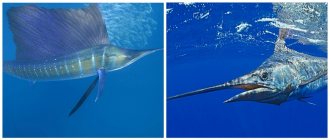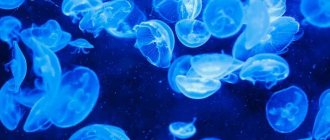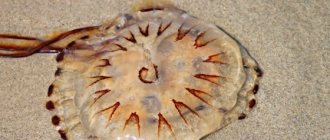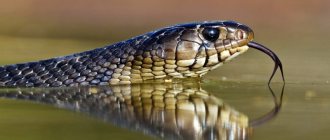- Wild animals
- >>
- Other animals
Jellyfish is considered one of the most ancient creatures that ever lived on the planet. They lived on Earth long before dinosaurs appeared. Some species are completely harmless, while others can kill with just a touch. People who breed fish keep jellyfish in aquariums, observing their measured rhythm of life.
Jellyfish description
The jellyfish has a gelatinous and sometimes almost cartilaginous body in the shape of a rain or lady's umbrella with a stem extending downwards or a bell with a tongue hanging down. Jellyfish has very beautiful photos - but it’s better to watch the video. Jellyfish fascinate with their beauty and smooth movements. The jellyfish is a truly beautiful and worthy animal.
In a jellyfish umbrella, you can distinguish a convex outer or upper side and a concave inner or lower side. From the center of the lower surface of the jellyfish's umbrella, either a very short or rather long stalk extends downwards, representing an oral tube; on the lower edge of this tube there are projections of various sizes located around the mouth opening, which are called oral lobes or oral tentacles.
The edge of the umbrella, equipped on its lower surface with a layer of muscles that serves to reduce the cavity of the bell and at the same time for the movement of the jellyfish, appears either dissected into separate blades, or has the form of a border running in the form of a ring perpendicular to the oral tube. Along the edge of the bell there are usually tentacles or lassoes, the number of which varies greatly; visual, auditory, and sometimes olfactory organs are also located right there.
What are the most beautiful jellyfish you will learn from the video:
The stomach of the jellyfish, communicating through the pharyngeal tube with the mouth, passes into a whole series of radiant canals or elongated pockets leading to the edge of the bell. Eggs and seminal cells develop in the stomach or on the walls of the canals extending from it.
What does the cornet jellyfish eat?
For the seas of Russia, the typical inhabitants are scyphoid jellyfish - the eared one, which we have already talked about, the lion's mane, the cornet. Cornerot (blue) jellyfish is one of the most common inhabitants of the Black Sea. Outwardly, this animal resembles a bell. Its body is fleshy, with a large number of oral growths in the lower part. Experts consider this species to be one of the most harmful - the burn after meeting them is quite painful.
The blue jellyfish uses its poison to paralyze its prey - worms, small fish, miniature crustaceans - everything that scyphoid jellyfish feed on.
A short message about jellyfish
Jellyfish live primarily in the ocean, but they are not actually fish, but plankton. These plants and animals either float in water or have such limited swimming ability that currents control their horizontal movements. Some plankton are microscopic single-celled organisms, while others are several meters long. Jellyfish can range in size from less than 1cm to almost 2m wide, with tentacles up to 30 meters long.
Jellyfish are also members of the class Cnidaria (cnidarians - from the Greek word for "nettle") and the class Scyphozoa (scyphozoa - from the Greek word for "cup", referring to the body shape of the jellyfish).
All cnidarians have a mouth in the center of their bodies, surrounded by tentacles. Cnidarian relatives of the jellyfish include corals, sea anemones and coryphella.
Jellyfish contain about 98 percent water.
If a jellyfish washes up on the beach, it mostly disappears as the water evaporates. Most of them are transparent and bell-shaped.
The body of a jellyfish has radial symmetry, which means that parts of the body extend from a central point, like the spokes of a wheel. Jellyfish have very simple bodies - they have no bones, brain or heart. To see light, detect smells and navigate, they have vestigial sensory nerves at the base of their tentacles.
The body of a jellyfish usually consists of six main parts:
- Epidermis, which protects internal organs
- Gastrodermis, which is the inner layer
- Mesoglea, or middle layer, between the epidermis and gastrodermis
- The gastrovascular cavity, which functions as the esophagus, stomach and intestines all in one
- An opening that functions as a mouth and anus
- Tentacles
An adult jellyfish is an invertebrate coelenterate (plural: medusae) named after the Gorgon Medusa, a mythological creature with snakes for hair that can turn a person to stone at a glance.
After the male jellyfish releases the reproductive cells through his opening into the water, they enter the female's opening and fertilize the eggs. Several dozen jellyfish larvae can hatch at once. They eventually float up in the current and look for a hard surface to attach to, such as a rock. When they attach, they become polyps—hollow cylinders with a neck and tentacles at the top. The polyps later disintegrate into young jellyfish called etherae. After a few weeks, the jellyfish swim away and become mature adult jellyfish.
Jellyfish can live from three to six months.
Incredible sequel
What happens next? The jellyfish larva is weak and small in size. She has neither poison nor menacing stinging cells, like adults. She can’t hunt yet, but she doesn’t need it, she has completely different tasks.
The planula sinks to the bottom and attaches itself to it, beginning to form into a polyp. The polyp grows, gradually learning to capture prey passing by.
And here, for everyone who decides to find out how jellyfish reproduce, the most interesting thing begins - the polyp stage ends with typical budding.
Scyphoid jellyfish
Scyphoid jellyfish are found in seas and oceans; they exist in salt water conditions. Creatures can move, with the exception of the sessile jellyfish, which practically does not move.
Basic qualities
Scyphoid jellyfish are representatives of sea creatures from the phylum Cnidaria; they survive both in low-temperature water and in warm reservoirs. There are approximately 200 species in total, they move with the current over long distances, but can move at will. The class of scyphoid jellyfish uses contractions of the dome, so water is actively released and a decent speed develops. The method of movement is called reactive.
Description
Representatives of scyphoid jellyfish are endowed with a dome-shaped body with an elongated configuration or resemble an umbrella; species can be quite large. The scyphoid class includes Cyanea arctica, reaching up to 2 m (diameter). There are many tentacles along the edges of the dome, their length reaches up to 15 meters. Stinging cells are located in this part of the body; they contain toxic substances necessary for protection from danger and obtaining food.
Body parts and how the body works
Scyphoid jellyfish have a simple structure; the mouth is located in the middle concave part of the dome, its corners serve as a transition to the oral lobes. They are needed for the delivery of food; in rooted species they are combined into an organ for filtering and eating plankton. Drawing the body parts helps greatly in studying the structure of the scyphoid jellyfish. In particular, they have a stomach with pockets shaped like four of them. Food moves throughout the body using a system of radial tubules. The exit of undigested particles is realized through the mouth; from the intestines, the remains are returned to the stomach.
The scyphoid jellyfish includes epithelial cells in 2 layers (endoderm and ectoderm). The space is filled with tissue of a jelly-like consistency (mesoglea). Scyphoid jellyfish belong to the type of cnidarians and are distinguished by high recovery abilities. The structure of the scyphoid jellyfish involves a large accumulation of nerve particles; they perceive light and sense balance.
Population and species status
If for most inhabitants of the seas and oceans pollution of water spaces has a negative impact, then for jellyfish it is, on the contrary, a positive factor, since recently the total number of these animals has been constantly increasing. This process has been confirmed by scientists from the University of British Columbia, who observe the life activity of such sea creatures.
This work has been carried out since 1960, with data available from 45 ecosystems, out of 66 existing ones. The study found that in 62 percent of the areas surveyed, jellyfish populations have increased, and significantly. This applies to the Mediterranean and Black Seas, the northeastern coast of the United States, the seas of East Asia, the Hawaiian Islands and Antarctica.
The data obtained indicate a disruption of the overall ecosystem, since the vital activity of jellyfish causes enormous damage to fisheries. In addition, jellyfish sting swimmers and vacationers, and also negatively affect the operation of hydraulic structures and end up in the water intake systems of ships.
In the Lake of Jellyfish, measuring 460 by 160 meters, there are several million golden and moon jellyfish. Nothing threatens their population, except for those who decide to swim in the company of numerous jellyfish. In fact, it is simply impossible to count them, since the number is simply huge.
The main stages of life and the appearance of new individuals
There are only two phases, so the life cycle of scyphoid jellyfish is divided into asexual existence and a period when reproduction is possible. They are heterosexual, the life cycle of scyphoids includes the development of germ cells, they come from the endoderm and mature in the stomach area (special folds are provided).
Scyphoid reproduction occurs in aquatic conditions. Scyphoid jellyfish reproduce by releasing eggs and sperm through the mouth; after fusion in the water, a blastula is created. A planula (larva) grows from it.
Scyphoid jellyfish reproduce after fusion: the larvae themselves attach to the substrate and form polyps capable of budding. Their dimensions are within a few mm. Next, the scyphoid jellyfish becomes covered with constrictions; the division process is called strobilation. A stack of individuals (ethers) is formed, they are attached to the strobile (central trunk). Gradually they break away and begin an independent life.
Phenomenal survivability
When answering the question of how long jellyfish live, scientists cite relatively small numbers. The average life expectancy is one to three years.
However, these creatures have phenomenal vitality and the highest reproduction rate. Numerous experiments have provided incredible data on the regenerative potential of jellyfish: if an individual is divided in two, both halves will quickly recover, survive, retain hunting skills and the ability to reproduce.
Life cycle of a jellyfish
The life cycle of a jellyfish includes the formation of a polyp, then a jellyfish, then a polyp again, and so on. As for the polyp, it differs from the jellyfish in the absence of a bell. Each polyp appears as a sac-like body, closed at one end; the closed lower end of such an individual is attached to some foreign object or to a polypnik, which sometimes floats freely or is attached to something.
The opposite end of the polyp is usually elongated in the form of a cone and in the center has an opening called the mouth, surrounded by tentacles. If we imagine that such a polyp, having separated from the object to which it was attached, will somewhat flatten in the dorso-ventral direction, then we will get a disk with tentacles along the edges and a mouth cone in the middle. From here it is not far to a real jellyfish: all that remains is for this disk to become convex and take the shape of a bell or an umbrella.
Life cycle of a jellyfish
Thus, the oral canal of the polyp turns into the pharyngeal tube of the jellyfish, and the edge of its oral disc, bordered by tentacles, into the edge of the bell of the jellyfish with its tentacles.
As for the bag-shaped stomach of the polyp, it turns into the vascular system of a jellyfish in water in the following way: its close walls grow together along the periphery over some distance, resulting in radially located channels. However, polyps differ from jellyfish not only in their structure, but also in other features, the most important of which is their different participation in the reproduction process. I wonder what jellyfish eat.
Features of character and lifestyle
Photo: Pink jellyfish
Since individuals are practically unable to resist sea currents, researchers classify them as representatives of plankton. They can swim against the current only by folding themselves into an umbrella and pushing water out of the lower part of the body through muscle contraction. The resulting jet pushes the body forward. Some species attach to other objects to move. The bags located along the rim of the bell act as a balancer. If the torso falls on its side, the muscles for which the nerve endings are responsible begin to contract and the body is aligned. There is not much to hide in the open sea, so transparency helps to camouflage well in the water. This helps you avoid becoming prey to other predators. Organisms do not hunt people. A person can only be harmed by jellyfish when they wash ashore.
Interesting fact: Jellyfish can regenerate lost body parts. If they are split in two, both halves will survive and regenerate into two identical individuals. When the larvae separate, the same larva will appear.
The life cycle of animals is quite short. The most tenacious of them live only up to one year. Rapid growth is ensured by constant food consumption. Some species are prone to migration. Golden jellyfish that live in Jellyfish Lake, connected to the ocean by underground tunnels, swim to the east coast in the morning and back in the evening.
Jellyfish feeding
Jellyfish feed on animals, because the jellyfish is a predator. It captures small crustaceans, plankton, and small fish. The diet of jellyfish is very varied and mainly depends on the place where the jellyfish lives. If there is no fish there, then the jellyfish won’t get it for lunch. The jellyfish's mouth is located directly under its "cap" or under its umbrella. The jellyfish shoots stinging cells at the victim and paralyzes it.
After this, it moves it into the mouth, and then begins to digest; everything that is not needed or cannot be digested is thrown into the water through the mouth. Some jellyfish can eat other jellyfish, even those of the same size. Sometimes the jellyfish eats the larvae and eggs of important seafood products such as oysters and shrimp. Many jellyfish are considered ocean filters. Since they can swallow sea water and eat everything that is there - process small animals and even garbage.
Jellyfish are carnivores - they eat other animals. The smaller jellyfish feeds on algae and other tiny plankton called zooplankton. Large jellyfish eat crustaceans and other large aquatic animals. They don't look for people to attack - their nervous systems are too simple to do that. Their bite is a defense mechanism and a way to capture their prey.
Each jellyfish tentacle is covered with thousands of cells called clinoblasts, which contain nematocysts containing stinging filaments. When the jellyfish collides with another object, the pressure inside the nematocyst causes the threads to unwind. The stinging cells shoot out at the unwitting victim like tiny darts, releasing poison into them.
Jellyfish venom is a neurotoxin designed to paralyze the jellyfish's prey. Although a jellyfish can kill small aquatic animals, its sting is not usually fatal to humans. But it can cause pain, skin rash, fever and muscle spasms. The degree of pain and reaction to a jellyfish sting can depend on the species—larger jellyfish have larger clinoblasts that can penetrate deeper into the skin, and some jellyfish have stronger venom than others.
When you're at the beach, watch out for jellyfish in both the water and the sand. Even a tentacle that has been separated from a jellyfish can sting. If you are stung, first remove any tentacles stuck to the skin. Do not wash the area with fresh water - the water will help the jellyfish release more venom into your body. Instead, wipe the bite area with alcohol, ammonia, vinegar, or urine (yes, you read that right). You can also use a mixture of baking soda and water. Any signs of an allergic reaction (shortness of breath, hives, swelling) require immediate medical attention.
Discoveries of scientists
Researchers have found that the population explosion was triggered by global warming, due to which conditions for the reproduction of jellyfish have improved. Not only have they increased their populations hundreds of times, but they have also become a serious threat to many ecosystems.
Other genera and species of jellyfish are also considered studied today. It has been established that reproduction can occur in one of two scenarios. Let's consider both methods of jellyfish reproduction in detail.
Protecting a jellyfish from predators and vice versa
Jellyfish have excellent defenses against predators: their stinging tentacles are a strong deterrent, and their transparent bodies help them hide. Several animals such as sea turtles and some fish species eat jellyfish. Some young fish actually even live inside jellyfish. They hide in tentacles to avoid being eaten by predators until they mature. And some people—especially in China and Japan—also eat jellyfish, considering them a delicacy.
Other than their occasional stings, jellyfish are generally not a nuisance. But in recent years, some parts of the world, namely Japan, Australia and Europe, have seen a problematic increase in jellyfish populations. Scientists believe the increase in jellyfish numbers may be due to additional nutrients in the water, climate change or fishing along the coastline. A dramatic increase in the jellyfish population is called a bloom.
Some researchers are concerned that increasing numbers of jellyfish could compete for food resources with fish and other marine animals, and ultimately outcompete native species. In large numbers, jellyfish also wreak havoc on the local fishing industry, creating holes in fishing nets and destroying other fish populations.
Invasion of Japan
For the first time, Japanese scientists from the University of Hiroshima began to study this issue seriously. It was noticed that the waters of the Pacific coast of the Land of the Rising Sun are simply teeming with nomura jellyfish (Nemopilema nomurai). Experts became interested in this increase in population and decided to find out its reason.
During the research, they were faced with the need to thoroughly study the question of how jellyfish reproduce.
It was found that the cycle is quite complex. And after birth, giant jellyfish babies, like snowflakes, behave just as aggressively and have the same gluttony as adults.
How does a jellyfish reproduce?
Jellyfish are organisms that develop reproductive products; polyps, which are one of the stages of development of jellyfish, the stage of the so-called nurse (since they give rise to the jellyfish themselves), reproduce asexually.
The polyps themselves develop from fertilized jellyfish eggs and are in turn produced asexually by jellyfish. There are, however, jellyfish from whose eggs only jellyfish develop; Polyps are also known that produce eggs and seed cells instead of jellyfish. Between these two extreme cases there are all sorts of transitions. With asexual reproduction, the vast majority of polyps form entire colonies, composed of individual individuals that remain connected to each other; the formation of such colonies is common for the order of hydroid polyps and hydroid jellyfish (Hydroidea). All of the main characteristics of hydroid polyps indicated are also characteristic of freshwater polyps, i.e. hydras.
The sexual generation of hydroid polyps are usually hydroid jellyfish, which are characterized by the presence of a membranous rim, the so-called sail, along the edge of the bell.
The final stage of jellyfish reproduction
Simply put, pieces of matter begin to detach from the polyp, which form into small jellyfish.
Scientists call this method of reproduction incredible, because it combines two main types: sexual and vegetative. It turns out that jellyfish reproduce by alternating these types.
By studying the details of how jellyfish reproduce, scientists have found that the vast majority of species follow this path. However, he is not the only one.
As you know, jellyfish have been roaming the seas for at least 600 thousand years. During this time they learned to survive. Reproduction variability may be one of the mechanisms of species conservation.
Hydroid jellyfish and polyps
Freshwater polyps are among the types of hydroid polyps that do not have alternation of generations, i.e., do not develop jellyfish. These same hydroid polyps include the so-called Sarsia, named after a Swedish naturalist; The reproduction of species of this genus is associated with alternation of generations.
The tubular sarsia itself (S. tubulosa) has the appearance of slender and weakly branched bushes, 10-15 mm high; its polyps, club-shaped, are covered with 12-16 tentacles scattered without any order. She lives in the Baltic Sea and settles on the underwater parts of wooden buildings, on sea grass, red algae and similar objects.
What are the most dangerous jellyfish - watch the video:
The club-shaped polyps of Sarsia bud, after a number of changes occurring in them, jellyfish, which are the sexual generation; These jellyfish, reaching 6-8 mm in width, are bell-shaped, equipped with a long oral tube and four long tentacles located along the edge of the bell at an equal distance from one another; At the base of each tentacle a simple eye is placed.
Mnemiopsis
This is not a native inhabitant of the Black Sea, but a guest from the eastern shores of the West Indies and the USA. The invasion of this species into the waters of the Black Sea has caused damage to fisheries. Work is currently underway to reduce the number of this species.
Mnemiopsis is a jellyfish that does not have stingers or tentacles. Its body reaches ten centimeters in length and six centimeters in width. This organism has the ability to glow (bioluminescence). What does the Mnemiopsis jellyfish eat in the Black Sea? This is mainly the caviar of small fish (sprat, for example), and zooplankton. Surprisingly, this organism continues to consume food even when the stomach is completely full. And when the stomach is full, excess food is thrown out in the form of a mucus ball. Another interesting fact is that with a lack of food, Mnemiopsis can live for three weeks.
sailboat
Adjacent to the order of hydroid polyps and hydroid jellyfish just described is the order of floating siphonophores, or tubular polyps (Siphonophora), free-floating colonies, some members of which are in the form of polyps, others in the form of jellyfish; in such colonies there are, in addition, feeding polyps armed with a long thread - a lasso, jellyfish-like individuals that produce egg cells and sperm, and, finally, some members of the colony turn into apparatus or bells that serve for the movement of the colony.
Swallowtail jellyfish
The flat siphonophores include the so-called swallowtail (Velella); this animal, swimming on the sea surface, has a disk-shaped body, pierced inside with air channels, with a crest standing vertically on its upper surface, which plays the role of a sail: on the lower side of the disk in the center there is one large feeding polyp, surrounded by many smaller ones; The tactile members of the colony are located along the edges of the disk.
sailboat
The most famous species of this genus is the common sailfish (Velella spirans), which can often be found very far from the shores, from which it is driven by the wind. In this animal, at the base of small polyps, small jellyfish-like creatures bud, which already develop sexual products and thus serve for the reproduction of the sailfish.
Endoderm and its functions
The inner layer of scyphoids forms a gastrovascular system: digestive canals, lined with glandular (secreting digestive juice) and phagocytic cells, extend from the intestinal cavity in rays. These structures are the main cells that break down food particles. The structures of the skin-muscle sac are also involved in digestion. Their membranes form pseudopodia, capturing and drawing in organic particles. Phagocytic cells and pseudopodia carry out two types of digestion: intracellular (as in protists) and cavity, inherent in highly organized multicellular animals.
Bubble
Another form, the bladder (Physalia), most of the body of which falls on a huge air sac lying horizontally on the water surface. On the lower surface of the bladder there are large and small feeding polyps, armed with long lassoes; the palps are also located here.
Bubble on the shore - photo
The common bladderwort (Ph. caravella), with purple, white-speckled polyps and a purplish-red air sac, playing the same role as the swallowtail scallop, is distributed in the Mediterranean Sea and the Atlantic Ocean. The dimensions of this form reach 30 cm in length (not counting the lassoes, which can extend very significantly).
Common bladderwort photo
Spreading
Jellyfish live in almost all salty seas. Science knows only one species of such freshwater inhabitants. Each species lives in one body of water and is almost never found in another ocean or sea. Jellyfish are divided into cold-water and heat-loving; deep-sea and those that live near the surface, although they rise to the surface only at night, and in the morning they dive into the depths in search of food.
The horizontal movement of these creatures is rather passive in nature - they are simply carried away by the current, sometimes over very long distances. Due to their primitiveness, jellyfish do not contact each other, being solitary animals.
Types of jellyfish
Akalephs
Representatives of the next order, acalephae meduza, differ from hydropolyps, hydromedusae and siphonophores, which are similar in structure to the polypoid and medusoid individuals of the entire colony, in the structure of both polyps and jellyfish: jellyfish of this order mostly reach quite significant sizes and have an umbrella , dissected at the edges into separate lobes.
As for polyps, their characteristic feature is the presence of four regularly located longitudinal swellings located on the inner wall of their gastric cavity; in the intervals between the indicated swellings there are 4 bags.
Reproduction of Akalephs
In some cases, the egg of a jellyfish develops directly into a jellyfish, but for the most part it turns into a small goblet-shaped polyp with tentacles around the oral disc; on such an embryo, sitting motionless on algae, etc., horizontal ring-shaped constrictions begin to appear, located one below the other; in this form, the entire embryo resembles a stack of plates; soon individual discs - future jellyfish - bud off one after another and, floating freely, turn into sexually mature forms.
Aurelia aurita
The suborder of broad-tentacled acalefs (Semostomae meduza), characterized by the presence of 4 long, boat-shaped simple tentacles located around a cruciform mouth, belongs to the eared jellyfish Aurelia aurita, which is very common in the Baltic and generally in the European seas; it is distinguished by a flat, like a watch glass, and sometimes hemispherical umbrella and narrow, lanceolate, strongly laminated at the edges, but not lobed tentacles.
This form, often found in huge masses, is well known to all explorers of our seas; The size of the eared jellyfish varies between 1 and 40 cm in diameter, but the most common specimens are 5-10 cm.
Hairy jellyfish
Another well-known acaleph jellyfish is the hairy jellyfish (Cyanea capillata), native to northern European seas. Like other species of this genus, the described jellyfish is distinguished by the edge of the bell, dissected into 8 main lobes, and the presence on its lower surface of many long tentacles - lassoes.
The described jellyfish appears in the fall, like the eared jellyfish, in masses - its main color is yellow-brown, sometimes reddish-yellow. It reaches 30-60 cm in diameter, but there are specimens more than 1 m in diameter and with tentacles more than 2 m long.
The northern hairy jellyfish (C. arctica) reaches even larger sizes, that is, over 2 m in diameter; the length of the tentacles of this species sometimes exceeds 4 m. This jellyfish is thus the largest of all jellyfish known to us.
Rootmouth jellyfish
As for root-mouthed jellyfish (Rhizostomeae meduza), they differ from the previous ones in the presence of 8 long, arranged in pairs, root-shaped mouth tentacles. In most cases, these tentacles grow together in pairs, and the mouth is completely closed and its role is played by many small sucking holes located along the tentacles.
Between the indicated stomata, these jellyfish often have more or less numerous oral palps, with button-shaped thickenings at the ends.
Cotylorhiza
An example of such a jellyfish can be the Mediterranean cotylorhiza tuberculata; it is a generally yellowish jellyfish, 10-20 cm wide in diameter with long sucking tubes or with suction cups on long legs; the edges of the disk of this jellyfish are mottled with white spots, the oral disk is fleshy red or yellowish-brown in color; milky-white tentacles, which, however, can sometimes be amber-yellow in color, brown, purple or violet blue, festoons surrounding the sucking holes - these are the features that describe the described jellyfish in more detail.
Disc jellyfish
Both mentioned groups of jellyfish, broad-tentacled and root-mouthed, constitute the suborder of disc-shaped jellyfish (Discomedusae), the characteristic features of which are:
- a flat, mostly disc-shaped bell or umbrella, usually with 8 peripheral sense organs;
- the edge of the bell is cut into no less than 16 blades; the stomach is surrounded by 8, 16, 32, or even a large number of gastric sacs;
- On the lower wall of the stomach there are gonads, which are very clearly visible in our eared jellyfish and are popularly called eyes.
Cuboid jellyfish
The next group of cuboid jellyfish (Cubomedusae) is defined by the following characteristics:
- a tall, cubic umbrella, the edge of which, reminiscent of the swimming edge of hydroid jellyfish, is in the form of a horizontally tense membrane or hanging downwards;
- on this edge there are 4 sensitive flasks, with an eye and an organ of hearing on each.
A representative of this group can be the Mediterranean common box jellyfish (Charybdea marsupialis), which is 2-3 cm wide and 3-4 cm high; this species, as well as other species of the same genus, is interesting for its unusually highly differentiated eyes, the structure of which resembles the structure of the eyes of vertebrates.
Sea wasp jellyfish
The sea wasp jellyfish is the most poisonous jellyfish in the world; it lives off the coast of Thailand and Australia. Its body is glassy and cube-shaped, that is, this jellyfish belongs to the cuboid jellyfish. Its stinging cells leave fatal burns. As a result, death can occur within 3 minutes.
However, there are survivors - people with strong hearts. There is an antidote against sea wasp jellyfish burns, but you must have it with you, since the victim has no more than 3 minutes from the moment of the burn to save a life. Therefore, you should swim only in places specially fenced off from jellyfish; if you decide to swim in the open ocean, then have an antidote with you.
Goblet jellyfish
Finally, the last group of goblet jellyfish (Stauromedusae) is characterized by the presence at the top of the goblet-shaped umbrella of a stalk, with the help of which the jellyfish is attached to algae, etc.; The tentacles, collected mostly in bunches, sit along the edge of the bell of these jellyfish.
Goblet jellyfish - photo
Lantern
The described suborder includes, among other things, the lanternfly (Lucernaria medusa), which belongs mainly to the northern seas; this form can move from place to place with the help of its tentacles, which is also helped by the jellyfish leg, which has the ability to arbitrarily attach or separate from underwater objects.
Photo of lantern jellyfish
In the northern European, as well as in the Black and Baltic seas, the largest (up to 7 cm) and long-known species of the described genus is found - the common lanternfly (L. quadricornis): this gray, green, brown-yellow or, finally, , the black-brown jellyfish willingly settles on red algae. It is also known on the shores of Greenland and found in America, off its northeastern shores.
Watch a video about jellyfish:
Jellyfish do best in their natural environment, but many aquarists have jellyfish tanks. People who capture and breed them in captivity must be very careful not to damage the jellyfish's fragile bodies. It is easier to collect jellyfish at the polyp stage, when they are less vulnerable. Ideally, they should be in an aquarium without any sharp edges or obstacles that could cause injury to them. Additionally, the water must have some flow because jellyfish mostly move with currents.
Irukandji syndrome
Irukandji is a type of box jellyfish found in Australia. This jellyfish is called the "Australian killer jellyfish." Although these jellyfish are small (about the size of a human finger), their venom is extremely toxic. The Irukandji jellyfish has clinoblasts on its body as well as on its tentacles. The sting of this jellyfish is so painful and causes such severe symptoms that scientists have named it: Irukandji syndrome.
Size comparison of Irukandji jellyfish
Irukandji jellyfish in water
Symptoms of Iryukanji syndrome include high blood pressure, vomiting, headaches, severe cramping and burning. Irukandji syndrome can last up to two weeks and there is no antidote. Doctors have found that magnesium infusions may provide some relief, but this jellyfish's sting can be fatal.
Stinging cells
Let's continue to study the structure of the scyphoid jellyfish and consider the mechanism by which animals defend themselves and also attack potential prey. Scyphoids also have another systematic name: the class Cnidarians. It turns out that in the ectodermal layer they have special cells - nettle, or stinging cells, also called cnidocytes. They are found around the mouth and on the tentacles of the animal. When exposed to mechanical stimuli, the thread located in the nettle cell capsule is rapidly thrown out and pierces the body of the victim. Scyphoid toxins that penetrate the cnidocoel are lethal to planktonic invertebrates and fish larvae. In humans, they cause symptoms of urticaria and skin hyperthermia.
Sense organs
Along the edges of the bell of the jellyfish, the photo of which is presented below, you can see shortened tentacles called marginal bodies - rhopalia. They contain two sense organs: vision (eyes that react to light) and balance (statocysts that look like calcareous pebbles). With their help, scyphoids learn about an approaching storm: sound waves in the range from 8 to 13 Hz irritate the statocysts, and the animal hastily moves deeper into the sea.
Sea wasp - the most dangerous jellyfish
Most people are afraid of poisonous spiders and rattlesnakes, but the most dangerous animal on the planet to humans may be a species of jellyfish - the sea wasp (Chironex fleckeri). With a bell the size of a basketball and tentacles up to 3m long, the sea wasp prowls the waters off Australia and Southeast Asia and has killed at least 60 people in the last century.
A slight touch of the tentacles of a sea wasp causes excruciating pain, and closer contact with these jellyfish can kill an adult in a couple of minutes.
What to do if you are burned by a jellyfish?
Tourists cannot always avoid accidents, even if they try to be careful.
Therefore, vacationers at any Black Sea resort need to know what to do in case of a jellyfish burn: • do not touch the affected area with your hands; • quickly rinse it, but not with fresh water, but with sea water; • use a napkin or dry towel to wipe the burn area; • treat it with table vinegar or soda solution; • apply ice wrapped in gauze or plastic.
It is very important to immediately contact a medical center, where experienced specialists will quickly assess the situation and provide assistance. You should also not expose affected skin to sunlight.
Jellyfish are among the simplest animals in the world
What can you say about animals without central nervous, cardiovascular and respiratory systems? Compared to vertebrates, jellyfish are extremely simple organisms, characterized mainly by wavy bells (which house the stomach) and tentacles containing many stinging cells. Their almost transparent bodies consist of only three layers of outer epidermis, middle mesoglea, and inner gastrodermis and water making up 95-98% of the total volume, compared to 60% in the average human.
Jellyfish have a unique way of delivering venom
The world's most venomous animals tend to release their venom when they bite, but not jellyfish (and other coelenterates), which have evolved specialized organs called nematocysts. When the jellyfish's tentacles are stimulated, enormous internal pressure is created in the stinging cells (about 2,000 pounds per square inch) and they literally explode, piercing the skin of the unfortunate victim to deliver thousands of tiny doses of venom. The nematocysts are so powerful that they can be activated even when the jellyfish is washed ashore or dies.











